some
information about
CORDS
(1978)
|
|
some
information about |
|
|
|
Me, holding the
modified Dan Armstrong plexiglas guitar that had
the pickups for the digital pitch extractor at Russ
Hamm's workbench, late 1977 or early 1978. |
One of the pieces of the new album's construction fell into place at the 1977 Audio Engineering Society convention at the Waldorf Astoria in New York (AES was small enough to hold in a medium-size hotel ballroom back then). Russell O. Hamm delivered a technical paper on his development of a digital pitch extraction device for guitars allowing them to control analog synthesizers. Russ had been brought into a project started by Walter Sear to develop a guitar synthesizer controller for Steve Howe of Yes. The original design was analog-based and never worked all that well. Russ eventually developed a digital approach that was presented in his paper at AES. I don't believe that Steve Howe was involved anymore by the time the digital approach was taken (Steve and I discussed this in the fall of 1997). |
Another element of Cords was
that for this album I had made a commitment to
record at least the first layer of tracks at home
and this time, keep them as a part of the final
recording instead of having to go back to square
one and re-record everything again in the studio.
MCI was coming out with a new 8 track 1 inch
multitrack recorder which seemed perfect for my
purposes and I placed an order in the late summer
of 1977. The machine was to be used as the exhibit
model on the floor at the AES convention and then
shipped to my house. When it arrived it turned out
to be serial number 001 of the JH-110/8 series of
tape machines. But since I wanted to get started
recording before the MCI machine was available,
AudioTechniques, which was the agent for the new
machine, loaned me a Brenell 1 inch 8 track until
the MCI was ready. The album was actually started
on the Brenell. Since it used the same tape format,
I was able to use the same tapes on the MCI when it
arrived in early October. The last big change was that
I first used the new Moog Polymoog (a true
polyphonic instrument, though still a kind of
cross-breed between a synthesizer and an
organ--it's pictured at the top of this page) for a
Synergy recording on Cords. I first used it on tour
with Nektar in 1976 and then on the first Peter
Gabriel album. Still, the bulk of the sounds on
Cords were patched on the modular Moog, the
Minimoog, the Oberheims, and some other small
synthesizers like Micromoogs and kits from PAiA.
That Polymoog was one of the 6 original
pre-production prototypes. I still have it though
the power supply died some time ago. I have the
service manuals and spare parts, but there's not a
lot of incentive to bring it back to life just
now. The Brenell 8 track
recorder used at the beginning of the recording of
Cords. An early photo shot in the work
room, probably fall 1977, which somehow became
circulated as a promo photo. Note the 1 octave PAiA
Oz keyboard on the Polymoog. This
is a dark and murky early photo of the workroom in
the fall of 1977 (it's the only photo that I've
found so far). Equipment that I can make out
clockwise from the left is: my small Yamaha mixer,
the patchbay, the Brenell 8 track, Oberheim SEM and
Sequencer modules on top of PAiA enveloper
followers, on top of a Minimoog, a Moog 15 cabinet
on top of an Oberheim DS-2 digital sequencer with a
custom matrix gate and CV switcher, and a Micromoog
on top of the Polymoog. Notice that the Mellotron
is retired. I had a makeshift studio in a
spare bedroom of the house that I was sharing with
some of the members of Nektar in Chatham Township,
New Jersey. This was the beginning of the Synergy
Studio as something more than a writing room for
me. I believe that the first pieces worked on were
the "On Presuming To Be Modern" trilogy. There were
sketches of many of the other pieces drawn from
notes made during informal writing sessions during
the preceding months. "A Small Collection of
Chords" was also an early piece using the
harpsicord-like voice from the Polymoog. The real breakthrough piece
was "Phobos". The basic melodic structure against a
click track had been around for a few weeks when I
decided to see how much of a rhythm track could be
created in real-time synched to the timing click
already on track 8. This involved marshaling just
about every sound generator, sequencer, sample and
hold circuit in the room and locking them together
fired by the click track. It took hours of
tweaking, especially in creating basic percussive
patches that would constantly evolve under the
sample and hold circuits; giving a controlled
randomness without getting too far out of control.
It was a long night, but when it was time to shut
down, there was an almost complete track. A long
tag of just the percussion track was run and that
became the basis for the guitar synthesizer work on
"Deimos". Another murky photo of the same
workroom in the Nektar house in Chatham, NJ taken
later that same fall. That's synth guitarist Peter
Sobel in the picture. This picture dates from
sometime after the fall 1977 AES Convention since
the new MCI JH-110/8 multitrack, serial number 001,
had been delivered after being displayed at the
show at the Waldorf Astoria in New York City. The
MCI replaced the loaner Brenell machine.
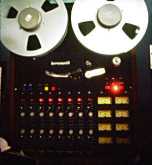
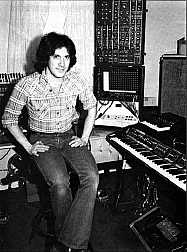
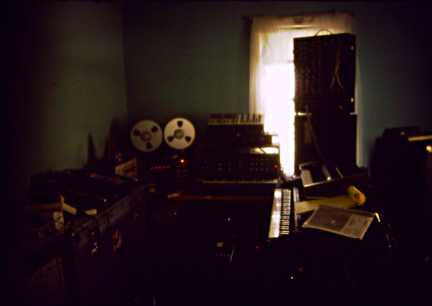
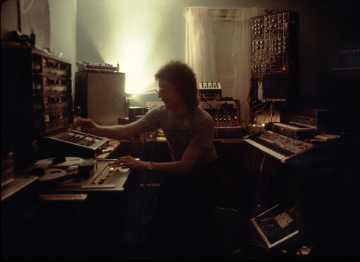
Other tracks were written in the coming months. By the first weeks of 1978 the production had moved back to House of Music, which since Sequencer had been recorded, had moved to a new location. The studio, which had literally been in the cellar of a little cape cod style suburban house, had moved to a beautiful 7 acre campus with a pond, pool, jacuzzi and all of the amenities that you'd expect in a new studio building which itself was built on to the existing house on the estate. Studio A was up and running and that's where most of the remaining recording on Cords was completed. Studio A was outfitted with an MCI JH-500 console and a JH-24 tape machine. There were new outboard toys like the recently introduced Eventide Harmonizer, and a new EMT digital reverb. Studio B was still under construction, but would be finished in time for Cords to be mixed there--the first mix in Studio B.
Overdubs in Studio A at House of
Music, West Orange, NJ probably around January or
February, 1978.
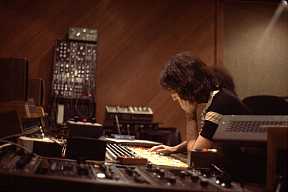
The first tracks of each piece were transferred from the 8 track master over to the first 8 tracks of the 24 track, and recording carried on from there. Starting in early 1978 I ended up doing double sessions. Peter Gabriel's second album, produced by Robert Fripp, got under way at The Hit Factory in New York. I found myself dividing my time and moving synthesizer equipment between the two studios. The winter of 1978 was a very tough one with several blizzards during February. Somehow, both albums got done. The influence of the Gabriel/Fripp connection infused itself into Cords. Robert's guitar loop technique was executed by Pete Sobel using the guitar synthesizer on the track that became "Terra Incognita". Instead of using Robert's Revox portable recorders we opted for an industrial strength pair of Studer A-80 two tracks with dbx noise reduction. While Cords was going together, only a few of the tracks had real titles. Peter Gabriel opened up his archive of unused song titles to me. "Full Moon Flyer" came from Peter. For some reason the early 1978 issues of Harper's and The Atlantic Monthly, which I was reading during the down time at the Hit Factory, were full of articles containing phrases that lent themselves to becoming song titles. "On Presuming To Be Modern", "Sketches of Mythical Beasts","Disruption In World Communications", and "Terra Incognita" all came from those magazines. "Trellis" was a working title that stuck and "Phobos and Deimos Go To Mars" flew in the window one day and stuck to the tape. It just seemed right thing to call the track.
This
is a Polaroid test shot of the Cords cover that the
photographer from Hipgnosis shot of himself before
the hired model showed up to be photographed in his
underwear. It was a freezing February night at the
corner of 22nd Street and the old elevated West
Side Highway in Manhattan. We were trying to get
the photo session finished before a major blizzard
blew into town. The cover photo was shot by
Peter Chistopherson of the noted English design
firm Hipgnosis along the now-demolished West Side
Highway near the foot of 22th Street in New York
City. It was shot in late February 1978 at night
just before a major snowstorm blew in. On the back
cover of Peter Gabriel's second album, there is a
daytime shot of Peter near the same location a few
days later after the storm, but with him located
under the highway structure. You can see the plowed
snow in Peter's shot. Hipgnosis did his cover too;
same photographer, same locations. The Cords cover
shot was taken about a block away from a rundown
place called the Terminal Hotel which caught my
attention and became a track title on my Audion
album two and a half years later.


Cords was mixed in Studio B at House of Music. Though the studio was equipped for computer automated mixing on its new MCI JH-528 console, the tracks had been planned so well that the mixing was fairly easy and didn't require the automation. Mixing was finished in April and mastered for LP and cassette by George Marino at Sterling Sound in New York. Passport Records made arrangements for all of the consumer pressings to be done on clear vinyl as a part of the fad for color vinyl releases at the time. Clear vinyl had the advantage of requiring virgin vinyl be used on the presses since any contaminants would show up. This forced all of the disks to be audiophile pressings. The downside was that the album's list price was a dollar higher, kicking off the higher list prices about to become standard in the industry. I took some heat for that in an interview about album pricing printed in Rolling Stone magazine. All of the regular release copies of Cords were in clear vinyl, but the radio promo copies were in black, making the black ones, in this case, the rarer and more collectible copies. The first editions of the LP were distributed through Arista and had a gatefold cover. Later pressings had a single sleeve and the "lightning bolt" on the cover art is tinted yellow instead of the plain white it originally had been.
Because the clear vinyl drew such a lot of attention, Passport soon reissued both Electronic Realizations and Sequencer in clear editions. These remained in circulation, along with Cords until LPs began to fade in the mid-1980s. (All of the subsequent Synergy LPs were issued in black starting with Games in 1979).
This
is the promotional photo distributed when the Cords
album came out. I had a bad cold and had been up
all night double shifting on both the second Peter
Gabriel album and my own work on Cords.
A
DJ radio edit
of Phobos and Deimos Go To Mars was sent out on
black vinyl 12" disks. This is the sticker from the
white sleeve trade-only
release.
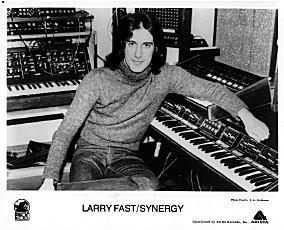
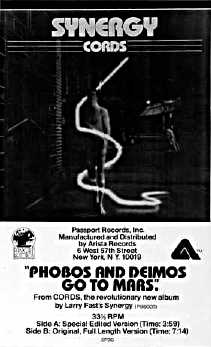
The album was scheduled for release in September 1978 to coincide with the Peter Gabriel tour. I did quite a lot of promotion in North America and Europe during that tour. There was an edited version of Phobos and Deimos released to radio, but there were no singles from the album that I'm aware of. Peter used "On Presuming To Be Modern I" to open the main part of his shows. During the tour I started sketching ideas that would become a parts of the Games album.
©1999-2001 Synergy® Electronic Music, Inc.
This page was last updated on January 29, 2001